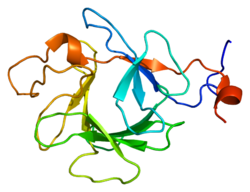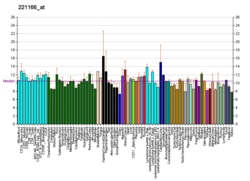
Summary
Fibroblast growth factor 23 (FGF23) is a protein and member of the fibroblast growth factor (FGF) family which participates in the regulation of phosphate in plasma and vitamin D metabolism. In humans it is encoded by the FGF23 gene. FGF23 decreases reabsorption of phosphate in the kidney. Mutations in FGF23 can lead to its increased activity, resulting in autosomal dominant hypophosphatemic rickets.
| FGF23 | |||||||||||||||||||||||||||||||||||||||||||||||||||
|---|---|---|---|---|---|---|---|---|---|---|---|---|---|---|---|---|---|---|---|---|---|---|---|---|---|---|---|---|---|---|---|---|---|---|---|---|---|---|---|---|---|---|---|---|---|---|---|---|---|---|---|
 | |||||||||||||||||||||||||||||||||||||||||||||||||||
| |||||||||||||||||||||||||||||||||||||||||||||||||||
| Identifiers | |||||||||||||||||||||||||||||||||||||||||||||||||||
| Aliases | FGF23, ADHR, FGFN, HPDR2, HYPF, PHPTC, fibroblast growth factor 23, HFTC2 | ||||||||||||||||||||||||||||||||||||||||||||||||||
| External IDs | OMIM: 605380 MGI: 1891427 HomoloGene: 10771 GeneCards: FGF23 | ||||||||||||||||||||||||||||||||||||||||||||||||||
| |||||||||||||||||||||||||||||||||||||||||||||||||||
| |||||||||||||||||||||||||||||||||||||||||||||||||||
| |||||||||||||||||||||||||||||||||||||||||||||||||||
| |||||||||||||||||||||||||||||||||||||||||||||||||||
| |||||||||||||||||||||||||||||||||||||||||||||||||||
| Wikidata | |||||||||||||||||||||||||||||||||||||||||||||||||||
| |||||||||||||||||||||||||||||||||||||||||||||||||||
Description edit
Fibroblast growth factor 23 (FGF23) is a protein which in humans is encoded by the FGF23 gene.[5] FGF23 is a member of the fibroblast growth factor (FGF) family which participates in phosphate and vitamin D metabolism and regulation.[6][7]
Function edit
FGF23´s main function is to regulate the phosphate concentration in plasma. It does this by decreasing reabsorption of phosphate in the kidney, which means phosphate is excreted in urine. FGF23 is secreted by osteocytes in response to increased calcitriol and phosphate.[8][9][10][11] FGF23 acts on the kidneys by decreasing the expression of NPT2, a sodium-phosphate cotransporter in the proximal tubule.[12]
FGF23 may also suppress 1-alpha-hydroxylase, reducing its ability to activate vitamin D and subsequently impairing calcium absorption.[7][13]
Genetics edit
In humans FGF23 is encoded by the FGF23 gene, which is located on chromosome 12 and is composed of three exons. The gene was identified by its mutations associated with autosomal dominant hypophosphatemic rickets.[14]
Clinical significance edit
Mutations in FGF23, which render the protein resistant to proteolytic cleavage, lead to its increased activity and to renal phosphate loss, in the human disease autosomal dominant hypophosphatemic rickets.
FGF23 can also be overproduced by some types of tumors, such as the benign mesenchymal neoplasm phosphaturic mesenchymal tumor causing tumor-induced osteomalacia, a paraneoplastic syndrome.[15][16]
Loss of FGF23 activity is thought to lead to increased phosphate levels and the clinical syndrome of familial tumor calcinosis. Mice lacking either FGF23 or the klotho enzyme age prematurely due to hyperphosphatemia.[17]
Over-expression of FGF23 has been associated with cardiovascular disease in chronic kidney disease including cardiomyocyte hypertrophy, vascular calcification, stroke, and endothelial dysfunction.[18]
FGF23 expression and cleavage is promoted by iron deficiency and inflammation.[19]
FGF23 is associated with at least 7 non-nutritional diseases of hypophosphatemia: aside from autosomal dominant hypophosphatemic rickets, X-linked hypophosphatemia, autosomal recessive hypophosphatemic rickets type 1, 2, and 3, Tumor-induced osteomalacia and Hypophosphatemic rickets with hypercalciuria.[18]
History edit
Prior to its discovery in 2000, it was hypothesized that a protein existed which performed the functions subsequently shown for FGF23. This putative protein was known as phosphatonin.[20] Several types of effects were described including impairment of sodium dependent phosphate transport in both intestinal and renal brush border membrane vesicles, inhibition of production of calcitriol, stimulation of breakdown of calcitriol, and inhibition of production/secretion of parathyroid hormone.
References edit
- ^ a b c GRCh38: Ensembl release 89: ENSG00000118972 – Ensembl, May 2017
- ^ a b c GRCm38: Ensembl release 89: ENSMUSG00000000182 – Ensembl, May 2017
- ^ "Human PubMed Reference:". National Center for Biotechnology Information, U.S. National Library of Medicine.
- ^ "Mouse PubMed Reference:". National Center for Biotechnology Information, U.S. National Library of Medicine.
- ^ Yamashita T, Yoshioka M, Itoh N (October 2000). "Identification of a novel fibroblast growth factor, FGF-23, preferentially expressed in the ventrolateral thalamic nucleus of the brain". Biochemical and Biophysical Research Communications. 277 (2): 494–8. doi:10.1006/bbrc.2000.3696. PMID 11032749.
- ^ Fukumoto S (2008). "Physiological regulation and disorders of phosphate metabolism--pivotal role of fibroblast growth factor 23". Internal Medicine. 47 (5): 337–43. doi:10.2169/internalmedicine.47.0730. PMID 18310961.
- ^ a b Perwad F, Zhang MY, Tenenhouse HS, Portale AA (November 2007). "Fibroblast growth factor 23 impairs phosphorus and vitamin D metabolism in vivo and suppresses 25-hydroxyvitamin D-1alpha-hydroxylase expression in vitro". American Journal of Physiology. Renal Physiology. 293 (5): F1577-83. doi:10.1152/ajprenal.00463.2006. PMID 17699549. S2CID 20559055.
- ^ Dance A (23 February 2022). "Fun facts about bones: More than just scaffolding". Knowable Magazine. doi:10.1146/knowable-022222-1. S2CID 247095495. Retrieved 8 March 2022.
- ^ Robling AG, Bonewald LF (February 2020). "The Osteocyte: New Insights". Annual Review of Physiology. 82 (1): 485–506. doi:10.1146/annurev-physiol-021119-034332. PMC 8274561. PMID 32040934.
- ^ Cha SK, Ortega B, Kurosu H, Rosenblatt KP, Kuro-O M, Huang CL (July 2008). "Removal of sialic acid involving Klotho causes cell-surface retention of TRPV5 channel via binding to galectin-1". Proceedings of the National Academy of Sciences of the United States of America. 105 (28): 9805–9810. Bibcode:2008PNAS..105.9805C. doi:10.1073/pnas.0803223105. PMC 2474477. PMID 18606998.
- ^ Brown RB, Razzaque MS (2018-01-01), Singh AK, Williams GH (eds.), "Chapter 31 - Endocrine Regulation of Phosphate Homeostasis", Textbook of Nephro-Endocrinology (Second Edition), Academic Press, pp. 539–548, doi:10.1016/b978-0-12-803247-3.00032-5, hdl:10012/15679, ISBN 978-0-12-803247-3, S2CID 102827267, retrieved 2023-05-04
- ^ Jüppner H (April 2011). "Phosphate and FGF-23". Kidney International. Supplement. 79 (121): S24–S27. doi:10.1038/ki.2011.27. PMC 3257051. PMID 21346724.
- ^ Rodríguez-Ortiz ME, Rodríguez M (2015). "FGF23 as a calciotropic hormone". F1000Research. 4: 1472. doi:10.12688/f1000research.7189.1. PMC 4815615. PMID 27081473.
- ^ "Entrez Gene: FGF23 fibroblast growth factor 23".
- ^ Zadik Y, Nitzan DW (February 2012). "Tumor induced osteomalacia: a forgotten paraneoplastic syndrome?". Oral Oncology. 48 (2): e9–10. doi:10.1016/j.oraloncology.2011.09.011. PMID 21985764.
- ^ Green D, Mohorianu I, Piec I, Turner J, Beadsmoore C, Toms A, et al. (December 2017). "MicroRNA expression in a phosphaturic mesenchymal tumour". Bone Reports. 7: 63–69. doi:10.1016/j.bonr.2017.09.001. PMC 5596358. PMID 28932769.
- ^ Huang CL (May 2010). "Regulation of ion channels by secreted Klotho: mechanisms and implications". Kidney International. 77 (10): 855–60. doi:10.1038/ki.2010.73. PMID 20375979.
- ^ a b Beck-Nielsen SS, Mughal Z, Haffner D, Nilsson O, Levtchenko E, Ariceta G, de Lucas Collantes C, Schnabel D, Jandhyala R, Mäkitie O (2019-02-26). "FGF23 and its role in X-linked hypophosphatemia-related morbidity". Orphanet Journal of Rare Diseases. 14 (1): 58. doi:10.1186/s13023-019-1014-8. ISSN 1750-1172. PMC 6390548. PMID 30808384.
- ^ David V, Martin A, Isakova T, Spaulding C, Qi L, Ramirez V, Zumbrennen-Bullough K, Sun CC, Lin H, Babitt J, Wolf M (2016-01-04). "Inflammation and functional iron deficiency regulate fibroblast growth factor 23 production". Kidney International. 89 (1): 135–146. doi:10.1038/ki.2015.290. ISSN 0085-2538. PMC 4854810. PMID 26535997.
- ^ Strewler GJ (May 2001). "FGF23, hypophosphatemia, and rickets: has phosphatonin been found?". Proceedings of the National Academy of Sciences of the United States of America. 98 (11): 5945–6. doi:10.1073/pnas.11154898. PMC 33399. PMID 11371627.
Further reading edit
- Kiela PR, Ghishan FK (January 2009). "Recent advances in the renal-skeletal-gut axis that controls phosphate homeostasis". Laboratory Investigation; A Journal of Technical Methods and Pathology. 89 (1): 7–14. doi:10.1038/labinvest.2008.114. PMC 4292907. PMID 19029978.
- Silve C, Beck L (June 2002). "Is FGF23 the long sought after phosphaturic factor phosphatonin?". Nephrology, Dialysis, Transplantation. 17 (6): 958–61. doi:10.1093/ndt/17.6.958. PMID 12032180.
- Quarles LD (July 2003). "FGF23, PHEX, and MEPE regulation of phosphate homeostasis and skeletal mineralization". American Journal of Physiology. Endocrinology and Metabolism. 285 (1): E1-9. doi:10.1152/ajpendo.00016.2003. PMID 12791601.
- Fukagawa M, Nii-Kono T, Kazama JJ (July 2005). "Role of fibroblast growth factor 23 in health and in chronic kidney disease". Current Opinion in Nephrology and Hypertension. 14 (4): 325–9. doi:10.1097/01.mnh.0000172717.49476.80. PMID 15930999. S2CID 23555353.
- Imel EA, Econs MJ (September 2005). "Fibroblast growth factor 23: roles in health and disease". Journal of the American Society of Nephrology. 16 (9): 2565–75. doi:10.1681/ASN.2005050573. PMID 16033853. S2CID 8612881.
- Liu S, Quarles LD (June 2007). "How fibroblast growth factor 23 works". Journal of the American Society of Nephrology. 18 (6): 1637–47. doi:10.1681/ASN.2007010068. PMID 17494882.
- White KE, Evans WE, O'Riordan JL, Speer MC, Econs MJ, Lorenz-Depiereux B, et al. (ADHR Consortium) (November 2000). "Autosomal dominant hypophosphataemic rickets is associated with mutations in FGF23". Nature Genetics. 26 (3): 345–348. doi:10.1038/81664. PMID 11062477. S2CID 38870810.
- White KE, Jonsson KB, Carn G, Hampson G, Spector TD, Mannstadt M, et al. (February 2001). "The autosomal dominant hypophosphatemic rickets (ADHR) gene is a secreted polypeptide overexpressed by tumors that cause phosphate wasting". The Journal of Clinical Endocrinology and Metabolism. 86 (2): 497–500. doi:10.1210/jcem.86.2.7408. PMID 11157998.
- Shimada T, Mizutani S, Muto T, Yoneya T, Hino R, Takeda S, et al. (May 2001). "Cloning and characterization of FGF23 as a causative factor of tumor-induced osteomalacia". Proceedings of the National Academy of Sciences of the United States of America. 98 (11): 6500–5. Bibcode:2001PNAS...98.6500S. doi:10.1073/pnas.101545198. PMC 33497. PMID 11344269.
- Bowe AE, Finnegan R, Jan de Beur SM, Cho J, Levine MA, Kumar R, Schiavi SC (June 2001). "FGF-23 inhibits renal tubular phosphate transport and is a PHEX substrate". Biochemical and Biophysical Research Communications. 284 (4): 977–81. doi:10.1006/bbrc.2001.5084. PMID 11409890.
- White KE, Carn G, Lorenz-Depiereux B, Benet-Pages A, Strom TM, Econs MJ (December 2001). "Autosomal-dominant hypophosphatemic rickets (ADHR) mutations stabilize FGF-23". Kidney International. 60 (6): 2079–86. doi:10.1046/j.1523-1755.2001.00064.x. PMID 11737582.
- Kruse K, Woelfel D, Strom TM, Storm TM (2002). "Loss of renal phosphate wasting in a child with autosomal dominant hypophosphatemic rickets caused by a FGF23 mutation". Hormone Research. 55 (6): 305–8. doi:10.1159/000050018. PMID 11805436. S2CID 46748089.
- Yamashita T, Konishi M, Miyake A, Inui K, Itoh N (August 2002). "Fibroblast growth factor (FGF)-23 inhibits renal phosphate reabsorption by activation of the mitogen-activated protein kinase pathway". The Journal of Biological Chemistry. 277 (31): 28265–70. doi:10.1074/jbc.M202527200. PMID 12032146.
- Saito H, Kusano K, Kinosaki M, Ito H, Hirata M, Segawa H, et al. (January 2003). "Human fibroblast growth factor-23 mutants suppress Na+-dependent phosphate co-transport activity and 1alpha,25-dihydroxyvitamin D3 production". The Journal of Biological Chemistry. 278 (4): 2206–11. doi:10.1074/jbc.M207872200. PMID 12419819.
- Bai XY, Miao D, Goltzman D, Karaplis AC (March 2003). "The autosomal dominant hypophosphatemic rickets R176Q mutation in fibroblast growth factor 23 resists proteolytic cleavage and enhances in vivo biological potency". The Journal of Biological Chemistry. 278 (11): 9843–9. doi:10.1074/jbc.M210490200. PMID 12519781.
- Larsson T, Zahradnik R, Lavigne J, Ljunggren O, Jüppner H, Jonsson KB (February 2003). "Immunohistochemical detection of FGF-23 protein in tumors that cause oncogenic osteomalacia". European Journal of Endocrinology. 148 (2): 269–76. doi:10.1530/eje.0.1480269. PMID 12590648.
- Campos M, Couture C, Hirata IY, Juliano MA, Loisel TP, Crine P, et al. (July 2003). "Human recombinant endopeptidase PHEX has a strict S1' specificity for acidic residues and cleaves peptides derived from fibroblast growth factor-23 and matrix extracellular phosphoglycoprotein". The Biochemical Journal. 373 (Pt 1): 271–9. doi:10.1042/BJ20030287. PMC 1223479. PMID 12678920.
This article incorporates text from the United States National Library of Medicine, which is in the public domain.







